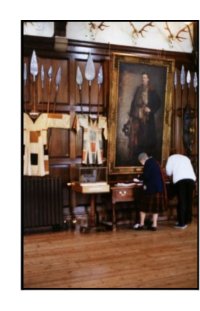No stone has been left unturned (pun intended) during this inquiry into the history of curling. Regretfully, Scotland's national bard, Robert Burns (1759-1796), says very little about the subject.; even the winter season merely impressed him by its gloomy, chilly aspects. That he understood the game may be inferred from his Eligy on Tam Samson in 1786. Tam, or Thomas, was one of his Kilmarnock friends and a zealous sportsman. Among his other qualities, Samson's prowess as an avid curler is noted as follows:
"When winter muffles up his cloak,
And binds the mire like a rock;
When to the loughs the curlers flock
Wi' gleesom speed,
Wha will they station the cock?
Tam Samson's dead!
He was the king o' a' the core,
To guard, or draw, or wick a bore,
Or up the rink like Jehu roar
In time o' need;
But now he lags on Death's 'hog-score'
Tam Samson's dead!"

Just as Canada owns hockey as its national sport, so Scotland lays its claim to the sport of curling. Perhaps The Curlers March was equally popular in its time as any Canadian tune composed for its Hockey Night in Canada theme. This reference appeared in a collection of Scottish airs by Alexander M'Clashan predating Burn's eligy by about eight years.

There's no need to transcribe the five stanzas of this ponderous march, since the purpose has been served in establishing its place in an historical time-line. The only other record of note is a "prescription" by Alexander Pennecuik, M.D., (1652-1722) of Auld Reekie (Edinburgh) for himself and for his patients in these words ~~~
"To Curle on the Ice, does greatly please,
Being a Manly Scottish Exercise
It Clears the Brains, stirs up the Native Heat,
And gives a gallant Appetite for Meat."

All of the preceding references belong to the modern era, but do very little to explain the geographical origins of curling. Our best clue seems to be that the country must have a winter cold enough to produce ice. Before galloping off into a study of etymology, logic reminds us that the English language has been influenced by many cultures, albeit mostly European. Thus we should not be surprised to find comments about any conclusions from the study of words involving curling will contain such words as "unreliable", "far-fetched", "absurd", or "over-estimated". Save your time and energy. Any "evidence" will fail to support the "conclusion" about origins.

On the other hand, there appears to be a record of the evolution of curling stones in Chapter II of A History of Curling by John Kerr, M.A., FSA Scot, Edinburgh, 1890. The earliest was the Kuting-Stone (Kuyyu-stane or Piltycock or Loofie) between 1500 and 1650. Then the Rough Block with handles superseded the rocks with holes for fingers and thumb. Finally, the Modern polished circular stone was developed; the example (to the right below) is the curling stone which belonged to Tam Samson.


It is evident that these curlers coited the early stones along the ice, but as to the exact style of the primitive game little further may be inferred. Until specimens of similar stones are found in other countries, Scots are entitled to claim that the game of curling is indigenous to Scotland.
 POSTSCRIPT
POSTSCRIPT


During August of 2001, while on a tour with the Canadian Massed Pipes and Drums, we visited Blair Atholl Castle.

In the photo to the right, the late Wendy Ross, Ontario Commissioner for the Clan Ross Association of Canada, is signing the guest book in the great hall. In the room prior to this one we were told that the game of curling was first introduced to Mary Queen of Scots. The hardwood floor certainly showed the marks of the stones, a few of which were prominently displayed around the building. Since the taking of photographs was prohibited, it is difficult to prove the veracity of the claim.

On page 62 of Sir Richard Broun's Memorabilia he states that Lord Darnley engaged in curling on a meadow during the severe winter he was forced to spend at Peebles. "This is the last tradition of the Royal patronage of ancient curling (if we may include the silly young lord in our list, because of his unfortunate marriage). There is such a circumstantial air about it that there may perhaps be more in it than in some of the other traditions. By those who had no good to report of Queen Mary it is said that, a few days after Darnley's murder, she was 'seen playing Golf and Pallmall in the fields beside Seton.'" Broun remarks that Darnley's neglect of his wife during the frosty winter may have been the fair widow's excuse for such conduct. Let all curlers be warned!
|
